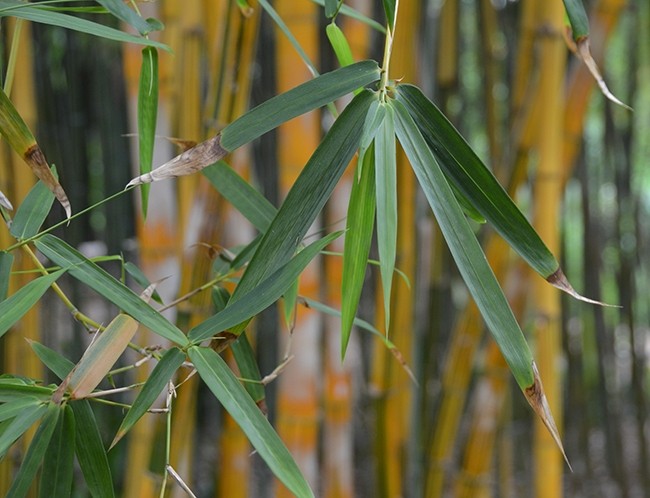Common bamboo
(Bambusa balcooa)

Description
Bambusa vulgaris, common bamboo, is an open-clump type bamboo species. It is native to Indochina and to the province of Yunnan in southern China, but it has been widely cultivated in many other places and has become naturalized in several regions. Among bamboo species, it is one of the largest and most easily recognized. Bambusa vulgaris forms moderately loose clumps and has no thorns. It has lemon-yellow culms (stems) with green stripes and dark green leaves. Stems are not straight, not easy to split, inflexible, thick-walled, and initially strong. The densely tufted culms grow 10–20 m (30–70 ft) high and 4–10 cm (2–4 in) thick. Culms are basally straight or flexuose (bent alternately in different directions), drooping at the tips. Culm walls are slightly thick. Nodes are slightly inflated. Internodes are 20–45 cm (7.9–17.7 in). Several branches develop from mid-culm nodes and above. Culm leaves are deciduous with dense pubescence. Leaf blades are narrowly lanceolate. Flowering is not common, and there are no seeds. Fruits are rare due to low pollen viability caused by irregular meiosis. At the interval of several decades, the whole population of an area blooms at once, and individual stems bear a large number of flowers. Vegetation propagates through clump division, by rhizome, stem and branch cutting, layering, and marcotting. The easiest and most practised cultivation method is culm or branch cutting. In the Philippines, the best results were obtained from one-node cuttings from the lower parts of six-month-old culms. When a stem dies, the clump usually survives. A clump can grow out of stem used for poles, fences, props, stakes, or posts. Its rhizomes extend up to 80 cm before turning upward to create open, fast-spreading clumps. The easy propagation of B. vulgaris explains its seemingly wild occurrence. The average chemical composition is cellulose 41–44%, pentosans 21–23%, lignin 26–28%, ash 1.7–1.9%, and silica 0.6–0.7%. Common bamboo is the most widely grown bamboo throughout the tropics and subtropics. Although mostly known only from cultivation, spontaneous (nondomesticated), escaped, and naturalized populations exist throughout the tropics and subtropics in and outside Asia. B. vulgaris is widely cultivated in East, Southeast, and South Asia, as well as tropical Africa including Madagascar. It is highly concentrated in the Indomalayan rainforests. The species is one of the most successful bamboos in Pakistan, Tanzania, and Brazil.
Taxonomic tree:







